
Queued Service Observing with MegaPrime:
Semester 2004B Report
02/03/05


|
Queued Service Observing with MegaPrime: Semester 2004B Report 02/03/05 |

|
A - Introduction
The Queued Service Observing (QSO) Project is part of a larger ensemble of software components defining the New Observing Process (NOP) which includes NEO (acquisition software), Elixir (data analysis) and DADS (data archiving and distribution). The semester 2004B was the fourth semester for which MegaPrime was used within the NOP system and it was by far the best queue semester with MegaCam. Weather was good for most of the semester (except at the end) and technical problems were less severe as with the past semesters. The 2004B semester was extremely complex on the scheduling process since several programs requested time constraints. We worked really hard to make sure that everything fits as much as possible! A very good number of programs were completed, our global efficiency improved, and the balance for the different Agencies was satisfying. The overheads with MegaPrime are still longer than with CFH12K so we are not as efficient on the sky as we were in the past, although guiding acquisition is now much more reliable. We are expecting overheads to go down early in 2005 since modifications to the guide probes will be applied. In conclusion, a very good semester and hopeful for the next one! In 2005B, we will also start operating WIRCam in a queue mode so it's going to be another challenge, with CFHT being operated in queue mode for ~300 nights per year....
B - General Comments
The 2004B semester
went really well, although we would like to have less time lost to bad weather
and technical problems, as always. The weather was generally great except
for the last 1.5 run. The run in September was exceptional with photometric
nights and stable seeing. After two runs only, we had already validated
80% of the total number of hours validated in the 2004A semester!
Unfortunately, the last run was much more difficult and we could not
complete all the programs we wanted to finish. The semester 2004B included
a lot of very difficult scheduling issues related to the presence of several
(13) PI programs with some time critical observations; in the context of
CFHTLS which represented 50% of the total time in QSO, this added considerable
complexity to the scheduling process. A positive aspect of the 2004B is that
the CFHTLS Steering Group got together more to discuss priorities for a given
run and transmitted those priorities to the QSO Team. Also, of course,
the accidental discovery of the improved image quality of MegaCam
by flipping L3 in the Wide-field corrector is another very positive result
coming out of 2004B!
Some general remarks on QSO in general for the semester 2004B:
1. Technically, the entire chain of operation, QSO --> NEO --> TCS, is efficient and robust. The time lost to the NOP chain is very small. This is a complex system and we have worked real hard to reduce the overheads on this. Glitches appear from time to time, mostly on the guide star acquisition, but the system is quite reliable and efficient.
2. The QSO concept is sound. With the possibility of preparing several queues covering a wide range of possible sky conditions in advance of an observing night, a very large fraction of the observations were done within the specifications. The ensemble of QSO tools allows also the quick preparation of queues during an observing night for adaptation to variable conditions, or in case of unexpected overheads. The introduction of the CFHTLS and several other PI programs with time constrained observations on a large-scale adds significant complexity to queue scheduling and requires much more work on planning of the runs. For 2004B, the global validation rate (validated/observed) was very good, one of the highest ever since we started QSO. A discussion on this is included in section C.
3. QSO is well adapted for time constrained programs. The Phase 2 Tool allows the PIs to specify time constraints. Two of the components of the CFHTLS have very restrictive time constraints. We can handle those easily if the weather is cooperative (of course!) although the introduction of time constrained observations on a large-scale adds up definitive complexity in the scheduling process.
4. Very variable seeing and non-photometric nights represent the worse sky conditions for the QSO mode. In 2004B, we were still a bit short on "shapshot" programs or regular programs requesting mediocre conditions (1" to 1.2"). As a result, we were often forced to observe programs in conditions worse than requested, mostly by the end of the semester. Again, we were able to calibrate all the fields requesting photometry but originally done during non-photometric conditions. The availability of Skyprobe and real-time measurements of the transparency is extremely valuable and regularly used do decide what observations should be undertaken.
5. Observations of moving targets is feasible in a queue mode. During the 2003A semester, we implemented a way of preparing observations for moving targets in our Phase 2 Tool (ephemeris tables). The process is a bit laborious but works really well and several programs have used this option again for 2004B as well. Non-sidereal guiding is not yet offered.
C - Global Statistics, Program Completeness, and Overheads
1) Global Statistics
The following table presents some general numbers regarding the queue observations for 2004B (C, F, H, K, L, and T, D-time, excluding snapshot programs). Note: 1 night is 9.5 hours.
|
Parameter
|
Number
|
| Total number of Nights |
116
|
| Nights lost to weather |
~25 (~22%)
|
| Nights lost to (engineering + technical) problems |
~ 9 (~7%)
|
| QSO Programs Requested |
47 (+ 3 snapshots)
|
| QSO Programs Started | 44 |
| QSO Programs Completed | 23 |
| Total I-time requested (hr.) |
678
|
| Total I-time validated (hr.) |
500.4 (74%)
|
| Queue Validation Efficiency |
~ 87.5 %
|
Remarks:
2) Program Completeness
The figure below presents the completion level for all of the programs in 2004B, according to their grade:
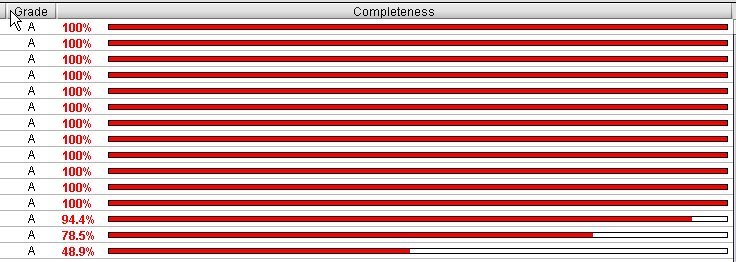
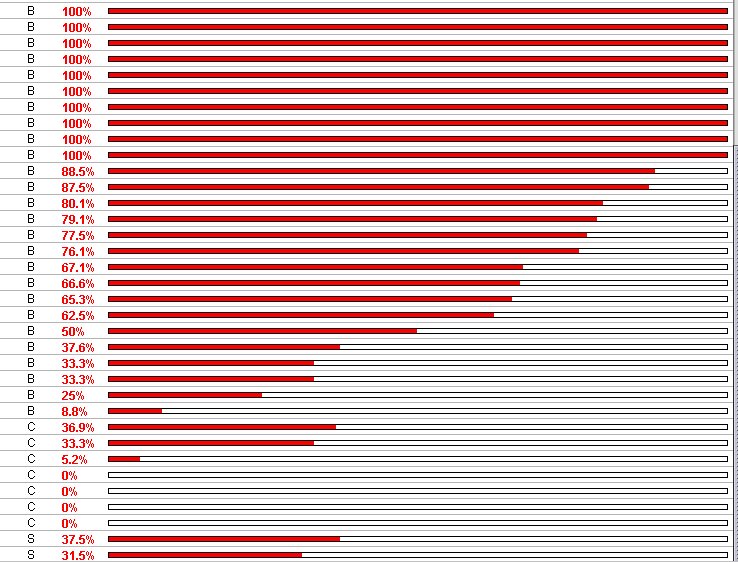
Remarks:
3) Overheads
There is no doubt that the overheads with MegaPrime are more important than with CFH12K. The following table include the main operational overheads (that is, other than readout time of the mosaic) with MegaPrime during the semester 2004B. The numbers have not really changed since 2003B; they are expected to change for 2005A since modifications to the guiders (software and hardware) are being made. This is given as a reference; overheads are highly variable during a given night depending on the conditions, complexity of science programs, etc.
|
Event
|
Events/night
|
Overhead
|
Total overhead per night
|
| Filter Change |
15 - 25/ night
|
90s /change
|
1500 - 2200 seconds
|
| Focus Sequence |
8 - 12 / night
|
200s / seq
|
1600 - 2400 seconds
|
| Dome Rotation > 45 d |
5 ?
|
120s
|
< 600 seconds
|
| Guide Star Acquisition |
20 - 30 ?
|
30 - 40 s / acq
|
600 - 1200 seconds
|
Remarks:
Note that overheads for calibrations (standard stars and Q98
short exposures for photometric purposes) are not included in this table.
For 2004B, we observed about 2 standard star fields during a photometric
night (12 minutes / fields due to filter changes).
D - Agency Time Accounting
1) Global Accounting
Balancing of the telescope time between the different Agencies is another constraint in the selection of the programs used to build the queues. The figure below presents the Agency time accounting for 2004B. The top panel presents the relative fraction allocated by the different agencies (program A + B), according to the total I-time allocated from the Phase 2 database. The bottom panel represents the fraction of observations validated (programs A+B+C) for the different Agencies, that is, [Total I-Time Validated for a given Agency]/[Total I-Time Validated]. As showed in the plots, the relative distribution of the total integration time of validated exposures between the different Agencies was balanced at the end of the 2004B.
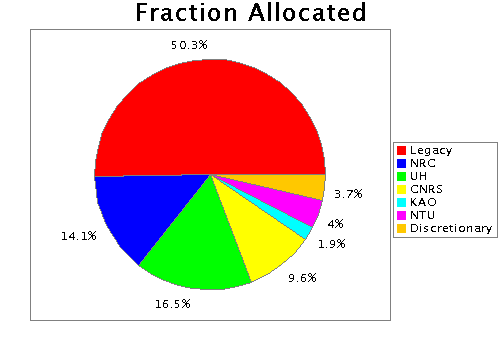
|
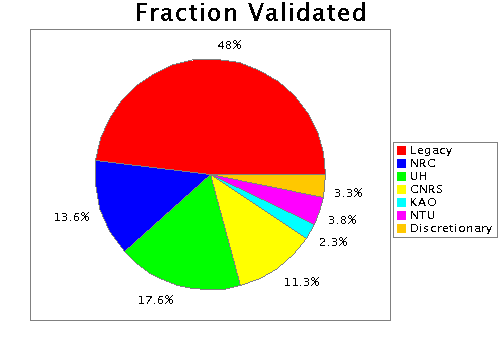
|
Remarks:
2 ) CFHTLS Accounting
The following figures show the time accounting for the different CFHTLS components:
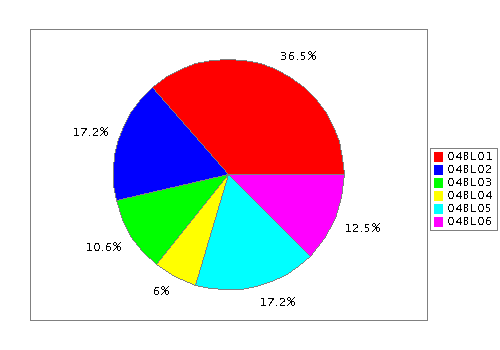
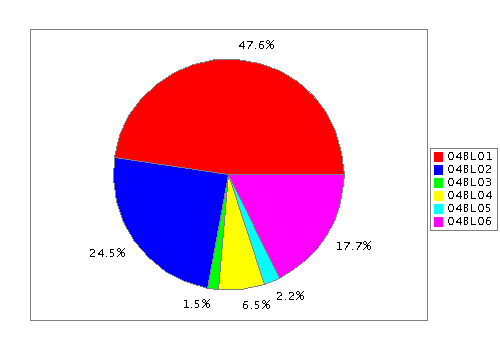
Since each component of the survey is divided into two programs, the global fractions are given in the following table:
|
Survey
|
Programs
|
Fraction Requested
|
Fraction Validated for 2003B
|
| Deep Synoptic | L01 + L04 |
36.5% + 6% = 42.5%
|
47.6% + 6.5% = 54.1%
|
| Wide Synoptic | L02 + L05 |
17.2% + 17.2% = 34.4%
|
24.5% + 2.2% = 26.7%
|
| Very Wide | L03 + L06 |
10.6% + 12.5% = 23.1%
|
1.5% + 17.7% = 19.2%
|
Remarks:
E - Conclusion
Our fourth semester with the queue mode with MegaPrime was quite a good one! The number of programs completed is quite high and the completion rate of 97% for A programs is quite remarkable. The Queue efficiency has also improved and balance of the Agencies was quite satisfying. Improving efficiency remains a high priority, in particular by increasing the validation rate and implementing the auto-focus feature, and we are hopeful that 2005A will be also quite productive on the science side.